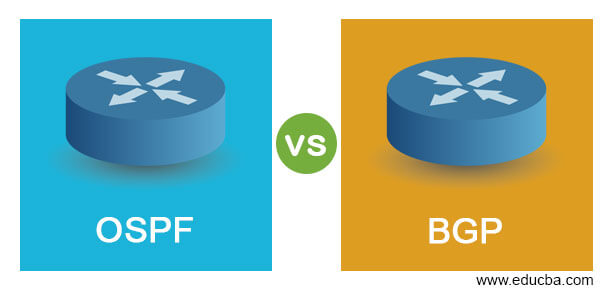Updated April 18, 2023

Difference between OSPF vs BGP
What is Open Shortest Path First (OSPF)?
The Open Shortest Path First (OSPF) protocol is a gateway protocol. The Interior Gateway Protocol (IGP) group was established with the goal of developing an IGP based on the Shortest Path First (SPF) algorithm for implementation in Internet Protocol networks. Link state routing is used. Because of the limitations of the RIP protocol, the OSPF was invented. The RIP protocol has limited capabilities of supporting big heterogeneous internetworks. OSPF is a link state routing protocol that can work in a hierarchical system. The autonomous system is the highest and most powerful entity in the hierarchy. For sending link state advertising, OSPF makes a call to the routers in the hierarchical area.
OSPF supports a variety of authentication systems, and each exchange between routers must be authenticated. Authentication is used to ensure that only authorised routers can broadcast routing information. For each type of service, separate routes to a single destination are calculated based on HOP count and high throughput. When there are a lot of low-cost paths to the destination, load balancing is used to distribute traffic evenly.
The set of networks in OSPF is grouped into a self-contained Area. The topology of a region is hidden from the remaining autonomous systems as well as adjacent areas. The routing traffic is reduced as a result of the information masking. OSPF uses different message formats to distinguish between information gathered within the network (internal sources) and information gained from an outside router (external sources).
What is Border Gateway Protocol (BGP)?
BGP is a form of mesh topology. The ideal path is chosen by the border gateway protocol. The transmission control protocol is utilised in the border gateway protocol.
The major distinction between OSPF (Open Shortest Path First) and BGP (Border Gateway Protocol) is that the former is an intra-domain routing protocol, whilst the latter is an inter-domain routing protocol.
Head to Head Comparison Between OSPF vs BGP (Infographics)
Below are the top differences between OSPF vs BGP:
Key Differences between OSPF and BGP
- BGP stands for Border Gateway Protocol, On the other hand, OSPF stands for Open Shortest Path First.
- OSPF is an Interior Gateway Routing Protocol (IGRP) that performs routing within an autonomous system. Whereas, BGP is an exterior gateway routing protocol that allows routing activities between two autonomous systems to be done.
- OSPF is simple to use, whereas BGP is difficult to implement.
- In OSPF, Internet protocol is used. On the contrary it, In BGP, a Transmission control protocol is used.
- OSPF works on Protocol number 89 Whereas BGP works on Protocol number 179
- Convergence is the amount of time it takes for a router to share and update the most recent routing information. As a result, OSPF can achieve convergence in less time. On the contrary to OSPF, the BGP has a slower convergence rate.
- The OSPF has a hierarchical structure, whereas BGP is commonly mesh-based.
- OSPF needs a lot of memory and CPU capacity. In BGP, on the other hand, the amount of device resources required is determined by the size of the routing table.
- BGP, unlike OSPF, is more adaptable as well as scalable and may be utilised on a bigger network.
- The OSPF’s main goal is to find the best, or fastest, route possible. BGP, on the other hand, places a premium on selecting the optimum path.
- BGP employs path-vector routing, while OSPF uses link state routing.
- In OSPF, Typically used on smaller-scale networks that may be managed centrally. While in BGP, typically found on large-scale networks like the internet.
Comparison Table of OSPF and BGP
| Sr. no. | OSPF | BGP |
| 1 | OSPF (Open Shortest Path First) is an internal gateway protocol. | BGP (Border Gateway Protocol) is an external gateway protocol |
| 2 | It is easy to implement | It is complex to implement |
| 3 | OSPF has a fast Convergence. | BGP has a slow Convergence. |
| 4 | It is a form of hierarchical network topology. | It is a form of mesh network topology. |
| 5 | It is also known as the internal gateway protocol. | It is also known as the external gateway protocol. |
| 6 | In this, Internet protocol is used | In this, the Transmission control protocol is used. |
| 7 | It works on Protocol number 89 | It works on Protocol number 179 |
| 8 | Need of device resources in OSPF, Memory and CPU Intensive | BGP scales better, although it is limited by the size of the routing tables. |
| 9 | It is a type of Link State. | It is a type of Path Vector State. |
| 10 | Dijkstra algorithm is used in this. | The best path algorithm is used in this. |
| 11 | The shortest path is preferred by OSPF above the shortest path. | On the other hand, prefers the best path. |
| 12 | Typically used on smaller-scale networks that may be managed centrally. | Typically found on large-scale networks like the internet. |
Conclusion
OSPF is a routing protocol for internal gateways, whereas BGP is a routing protocol for external gateways. OSPF is based on link state routing, in which each router broadcasts the status of its neighbouring router to all other routers in the vicinity. BGP, on the other hand, is based on path-vector routing, which means that a router has a list of networks that can be reached, as well as the way to each of them.
Recommended Articles
This is a guide to OSPF vs BGP. Here we discuss the OSPF vs BGP key differences with infographics and a comparison table. You may also have a look at the following articles to learn more –

